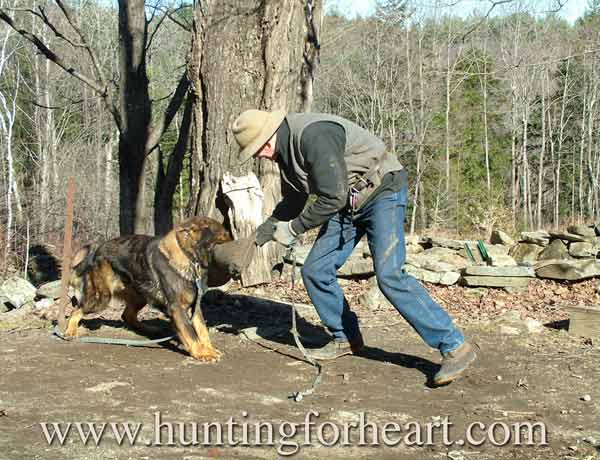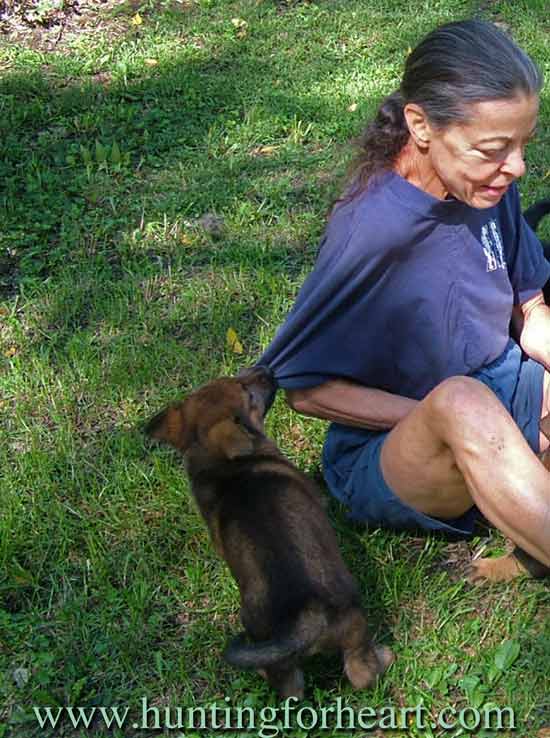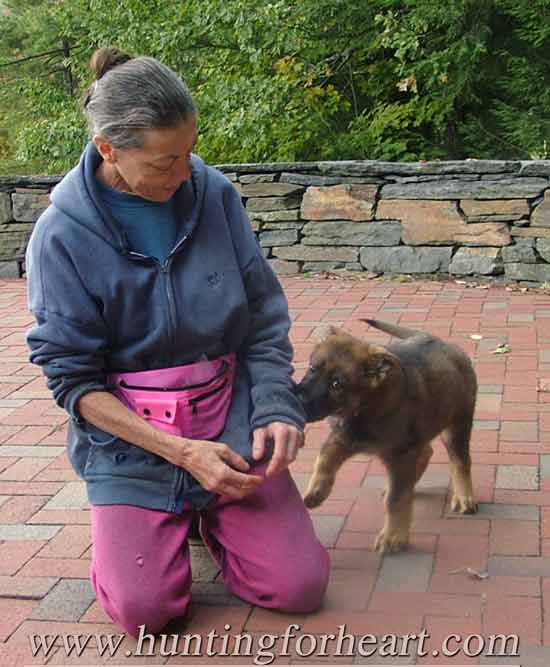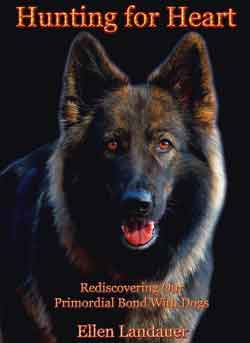Training Puppy Not to Bite
by Ellen Landauer
Training puppy not to bite: The vast majority of dog 'experts' have no clue - AND it's easier than you think!

PHOTO: Natural Dog Training originator Kevin Behan playing tug to channel dog's energy.
'The stronger a dog's desire to bite, the greater their capacity for cooperation.' - Kevin Behan, founder of Natural Dog Training
Awhile back, I was in town and a neighbor came up to greet me. He told me he and his wife just got a new female puppy.
'Oh, that's great - tell me about her,' I replied.
'Well, she's an Australian Shepherd, about 12 weeks old. But we may not be able to keep her.'
'Really? What's the problem?'
'She's got a biting problem; she wants to bite me and my wife ALL the time!' the man exclaimed. 'We have tried everything, and my wife is terrified of her.'
'Ah, that's easy to solve,' I said. 'I would be happy to help you with training puppy not to bite.'
We arranged a time for me to come over and instruct both the humans and the alleged canine land-shark.
Training Puppy Not to Bite:
Overcoming Fear

PHOTO: Training puppy not to bite: relax (and wear your crappiest clothes)!
My neighbors had the pup crated by the back door (very good) and let her out into the spacious back yard when I arrived. Armed with a pouch full of cubed chicken, and a puppy bite rag made of jute on my belt, I walked with them and observed the little Aussie.
I asked the couple to remain neutral so I could see the pup's level and manner of engagement with us. She romped about a bit, taking in the presence of a new person.
I noticed the woman seemed apprehensive. This is a perfect way to bring out the predator in a dog. After all, eons of carnivore existence handed down from the legacy of the wolf - has hardwired every dog on earth to hone in on the weaker prey - indicated by the prey animal's agitation.
By UTILIZING this primal path in our training, we can have a dog that is irresistably attracted to us, highly tuned in and very biddable. If we try to suppress or obstruct the primal attraction our pup has for us, we are destroying the very fabric of what makes a dog the most cooperative animal on the face of the earth.
I watched as the pup approached the woman. The pup seemed a little nervous, too. The woman reached down to pet her. Suddenly, the pup locked her jaws on a mouthful of the woman's jeans and erupted in a blind rage, shaking her head violently back and forth, yanking on the fabric and growling.
This told me that already, in this little pup, stress of all the things the couple did to 'try everything' for training puppy not to bite had already built an explosive charge.
I knelt down and started gently and contactfully massaging the pup's back. She began to calm down and lost interest in the woman's pant-leg, then rolled on her back. I rubbed her belly. She turned and put her jaws on my wrist. I was totally relaxed, not afraid, and let my hand be totally limp in her mouth.
The pup did not bite - just mouthed me a little, then stood up. I took a little food out of the pouch (food helps increase the social / emotional flow) and let the pup push toward me to get the food out of my cupped hand.
The man and woman seemed calmer, seemed to get it that fear (read terror) was unjustified. I explained that the more they oppose and try to suppress, punish and control her biting, the more she will NEED to bite them.
Training Puppy Not to Bite:
Correct Use of a Bite Toy Goes a Long Way
I suggested to them that they can give their Aussie girl the means to express her attraction to them by gripping with her jaws in a way that they will not get bitten - through use of the toy. I showed them how to use it in a way that the pup feels connected and in harmony with them.
With the pup on a long line, I tempted her with the toy. (The long line prevents the pup from running off to hide with the toy, keeps them engaged). My emotional state was calm and welcoming, unafraid of her desire to bite. To do this with a pup, the toy needs to move more than you do. If you are flailing your arms about and happen to have a toy in your hand, the pup may very well want to grip your arm. But if the movement of the toy is more interesting, the pup will tend to go for the toy.
Once the dog captures the toy, you can run a bit with them. Carrying the toy and running together increases the harmonic connection between you. This is because it taps a deep primal memory of a perfect conclusion to the hunt.
If the pup does grab you, you have the long line attached to their collar. Gently and steadily lift up on the lead, gradually increasing pressure. The pup will let go at the point they get too uncomfortable.
Do not reprimand or even speak to them. You may think this is counterintuitive, that you NEED to reprimand them so they know they did the wrong thing. If you reprimand them, then the pup will attribute any stress or discomfort to YOU. If YOU become the 'problem' that harms the bond with your companion.
You see, in training puppy not to bite, THEY need to perceive that THEIR behavior is what is making them uncomfortable. If you use your voice when lifting the lead, the pup will attribute their discomfort to YOU, NOT to their behavior. You want training to come from the inside, not be imposed from the outside. That is real training.
When you wish to disengage your pup from the toy, have some delightful treats handy and back away as they hone in on the treats. As they consume their treats, you can either pick up the toy and hang it back on your belt, or just lead the pup away and pick up the toy afterwards.
Disaster averted: The good news is, my neighbors kept their little Aussie pup. I occasionally see them out walking with her and they all look happy together.
Training Puppy Not to Bite: Another Way

Training puppy not to bite - this is an awesome opportunity, NOT a problem!
Kevin Behan asked, 'Why do you think dogs would rather play with other dogs than with humans?' His explanation, 'Because owners suppress the pup's desire to grip them with their mouths. They then connect with dogs better than they connect with us because they get to grip the other dogs with their jaws when they play.'
The pup's desire to put their mouth on people is a pure expression of how attracted they are to us, and how much they want to connect. When we repress, suppress and reprimand them for this impulse, we drive an emotional wedge between us and our pup. This makes training much harder. It also builds up a burden of compressed emotional charge (deep inner stress).
This accumulated deep inner stress is energy that is stuck, not moving. It manifests as all kinds of behavior problems - you name it. Housebreaking problems, fearful or aggressive behavior, destroying couches, rugs, etc.
By opening to and being calm in the face of our pup's drive - and correct use of food and toys to channel your pup's attraction to you - you will achieve a bond the like of which most can only dream.
Training Puppy Not to Bite: Same Principles Can Help Heal Rescue Dogs
BUY 'Hunting for Heart' and
Rediscover Your Primordial Bond With Dogs
BUY the
Book
HEALTH INFO
FOR YOU
My other website:
Peak health helps you have more energy to enjoy your dog!
